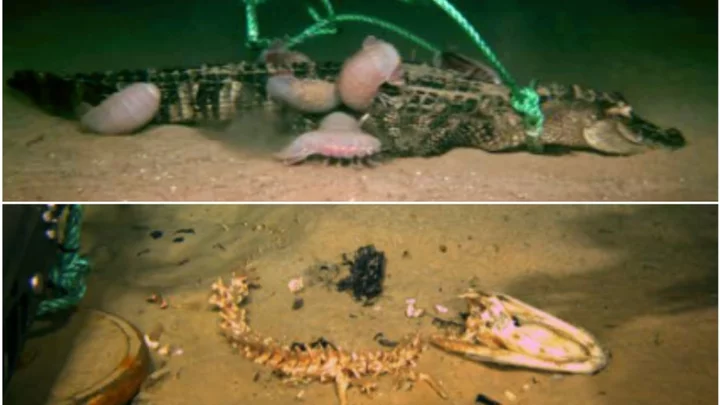A warning to readers who don’t have a fear of the deep ocean: this story might soon change that.
Back in 2019, a group of researchers who wanted to stir excitement down in the murky recesses of the sea conducted a unique experiment.
The team, from the Louisiana Universities Marine Consortium (LUMCON), dropped three dead alligators 6,560 feet (2,000 metres) down into the Gulf of Mexico to see how deep-dwelling creatures would react to an uncommon food source.
Initially, the scientists thought that the tough hide of the reptiles would put scavengers off, because it would make it hard for them to reach the more desirable soft flesh.
However, this swiftly proved to be far from the case.
Within a day, nine large isopods (Bathynomus giganteus) were observed feasting on the first carcass, eventually penetrating its hide and eating their meal from the inside out – imagine a crew of foot-long, pink woodlice crawling all over a gator and you get the picture.
The second croc, dropped around 100km away, was almost totally devoured in just 51 days – leaving behind nothing more than its skull, spine, and the rope and weight that were used to anchor it to the sea floor.
The scant leftovers became a source of great excitement to the researchers when they noticed it had been targeted by a brand new species of bone-eating worm.
They concluded that it appeared to be a member of the Osedax family – commonly known as "zombie worms" because they suck away at, and live off, the bones of the dead – which had never been seen around Mexico before.
Testing revealed that its nearest identifiable relatives are native to Antarctica and California, therefore making it an “undescribed species”.
The investigators wrote in a paper about their discovery, which was published in the journal PLOS, that the creature “will be named in due course”.
So, what happened to the third alligator?
Well, that part is a mystery, because within eight days of its drop-off at its 1,996-metre-deep observation spot, it had disappeared.
The researchers noted that although the body had vanished, the 20.4kg anchor, shackle and rope used to weigh the animal down were found 8.3 metres away – suggesting they had been “dragged” there.
The experts concluded that a “large scavenger” had most likely snapped up the reptile. And given the depth at which it had been left, and the “implied body size necessary to both consume a moderately-sized alligator and move a large weight” it was probably a large shark.
Clearly, whatever the beast was, it didn’t feel like sharing its dinner with a bunch of greedy worms.
Sign up for our free Indy100 weekly newsletter
Have your say in our news democracy. Click the upvote icon at the top of the page to help raise this article through the indy100 rankings.

